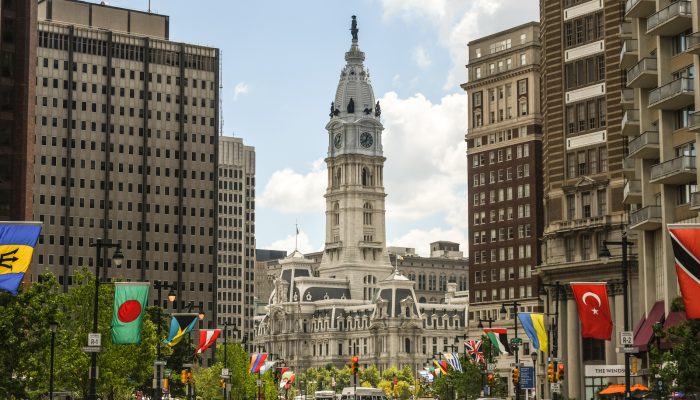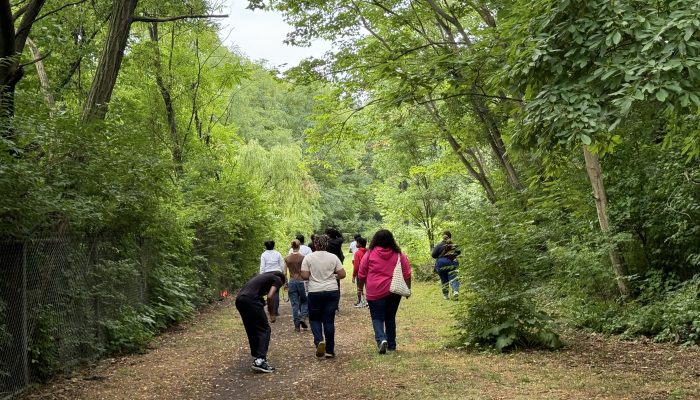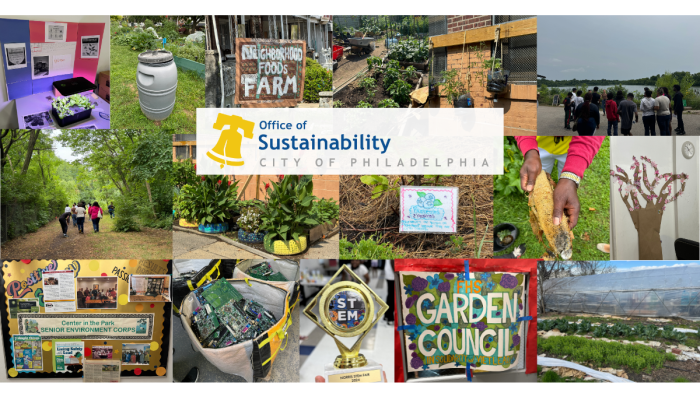Philadelphia is known for its iconic historic buildings. From the Office of Sustainability’s location at a terminus of the Benjamin Franklin Parkway, we can see the Second Empire style Philadelphia City Hall (completed 1901), the Classical Revival Philadelphia Museum of Art (completed 1928), and the Brutalist Municipal Services Building (completed 1962).
For Director of Sustainability Liz Lankenau, who started her career as a historic preservation planner, preserving the character-defining historical and cultural assets of Philadelphia goes hand-in-hand with sound climate mitigation policy. According to Liz, “Preservation and energy efficiency can unite to deliver on Mayor Cherelle L. Parker’s vision for Philadelphia as the safest, cleanest, greenest big city with access to economic opportunity for all.” In this blog, we look at how protecting the unique character of our city and historic structures can help the city achieve its climate goals.
Historic preservation as an important climate action tool
Philadelphia’s industry and buildings, historic and modern, account for nearly 70% of citywide carbon emissions. For Philadelphia to meet its climate goals, we need to make our buildings of all ages more energy efficient.
We often think about the carbon emissions generated by operating buildings – the energy used for heating and cooling, keeping the lights on, and running appliances. However, constructing new buildings can also generate significant emissions. These emissions are known as “embodied carbon,” and they include the extraction, production, transport, and manufacturing of building materials, plus the energy that goes into construction.
Historic preservation minimizes embodied emissions by “reusing” existing buildings, minimizing the footprint of new building materials. Retrofitting these existing buildings by upgrading and improving the building’s technology and energy efficiency can then reduce the building’s operating emissions. The impacts of preserving and retrofitting existing buildings can be significant:
- According to the World Economic Forum, retrofitting an existing building can result in 50-75% less embodied carbon than constructing a comparable new building, while also reducing ongoing operational emissions by at least 40%.
- It can take 10-80 years to offset the carbon emitted by replacing an old building with a new, energy-efficient one.
Preserving buildings and neighborhoods can also boost economic development by:
- Fostering high-quality, family-sustaining green and skilled trade jobs;
- Increasing neighborhood investment;
- Contributing to our tourism economy;
- Reducing our reliance on cars because older neighborhoods tend to be more walkable by design, with a higher concentration of local businesses and services.
The City has successfully adapted its historic buildings into high performance, green municipal buildings. Most recently, the City renovated the historically designated Philadelphia Inquirer building into the Philadelphia Public Services Building that achieved a LEED Silver certification in 2022.
Home preservation and energy conservation
According to the National Trust’s Preservation Green Lab, the average house in Philadelphia is 93 years old, which is almost 30 years older than the national average. With proper upkeep and retrofitting, we can make older homes and buildings safer, energy-efficient and healthier, while preserving neighborhood character. The City, state and federal government offer resources to support residents with retrofitting and preserving homes:
- Philadelphia Energy Authority’s Built to Last program is a “one-stop shop” whole home repair program serving low-income Philadelphia homeowners. It coordinates home repair, energy conservation, and healthy homes programs to retrofit residential buildings.
- Pennsylvania’s Historic Preservation Tax Credit helps qualified taxpayers restore a historic structure into an income-producing property.
- The Philadelphia Historic Commission and the Preservation Alliance for Greater Philadelphia can provide information related to working with buildings designated as historic.




